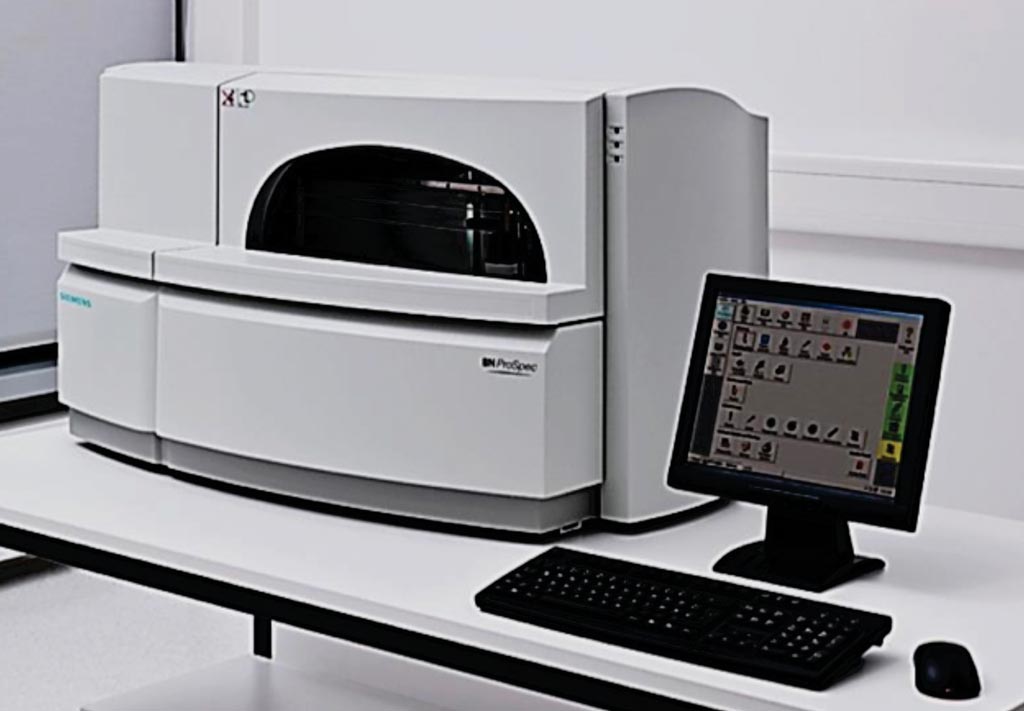Cytokine Concentration Correlates with Diabetic Nephropathy
By LabMedica International staff writers
Posted on 01 Mar 2017
Diabetic nephropathy (DN) is a major microvascular complication of diabetes mellitus, and it is the leading cause of end-stage renal disease and inflammation plays some important roles in the pathogenesis of DN.Posted on 01 Mar 2017
Interleukin-19 (IL-19) is a newly discovered cytokine belonging to the Interleukin-10 (IL-10) family. IL-19 cytokines have indispensable functions in many inflammatory processes and also can induce the angiogenic potential of endothelial cells.

Image: The BN Prospec System for particle enhanced immuoturbidimetric methodology (Photo courtesy of Siemens Healthineers).
Scientists at the Jiangsu University School of Clinical Medicine selected 200 patients with type 2 diabetes mellitus (T2DM) (109 males and 91 females, age 60 ± 10.3 years) from July to December in 2015. According to urinary albumin excretion rate (UAE), the patients were divided into three groups: 102 patients with T2DM with normoalbuminuria, (UAE < 30 mg/24 hours), 72 T2DM patients with microalbuminuria (UAE: 30 to 300 mg/24 hours) and 26 T2DM patients with macroalbuminuria (UAE ≥300 mg/24 hours). There were 50 healthy blood donors enrolled for the control group.
All subjects were assessed for: IL-19, High-sensitivity C-reactive protein (Hs-CRP), Cystatin C, urinary albumin excretion rate (UAE) and glycosylated hemoglobin A1C (HbA1c). IL-19 was determined by the enzyme-linked immunosorbent assay (ELISA) kits. Urinary albumin and Hs-CRP concentrations were assessed using the particle enhanced immuoturbidimetric method. HbA1c was measured by liquid chromatography. Fasting plasma glucose (FPG), total cholesterol (TC), high-density lipoprotein (HDL-C) and LDL cholesterol (LDL-C) were measured by enzymatically.
The team found that the serum IL-19 levels in DN patients were found to be significantly higher compared to controls. IL-19 levels were significantly positively correlated with Hs-CRP, Cystatin C, UAE and HbA1c. In multivariable logistic regression analysis, IL-19 levels (95% CI, 20.1 to 62.9) alone showed a significant positive association with DN even after adjusting for age, gender, hypertension, and blood fat. The HbA1c in the microalbuminuric/macroalbuminuric diabetic group were significantly increased compared to normoalbuminuric and control groups.
The authors concluded that that IL-19 levels was significantly elevated in the patients with diabetic nephropathy and was associated with Hs-CRP, Cystatin C, UAE and HbA1c. The results suggest that IL-19 has an important role in the acceleration of glomerular injury in addition to its inflammatory effect on this pathophysiology, and provide further insights into the understanding of IL-19 as the possible effectiveness of anti-inflammatory therapy for DN treatment and prevention. The study was published on February 15, 2017, in the journal BMC Nephrology.













